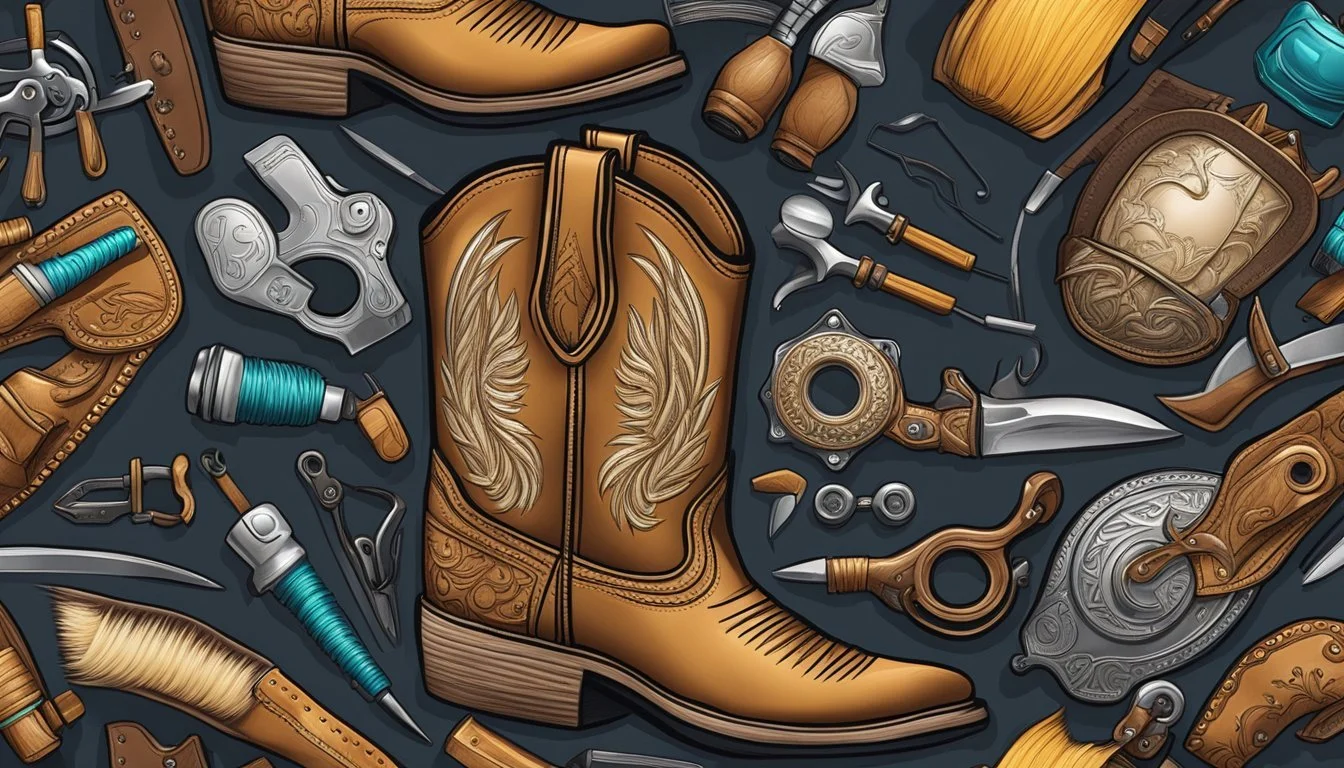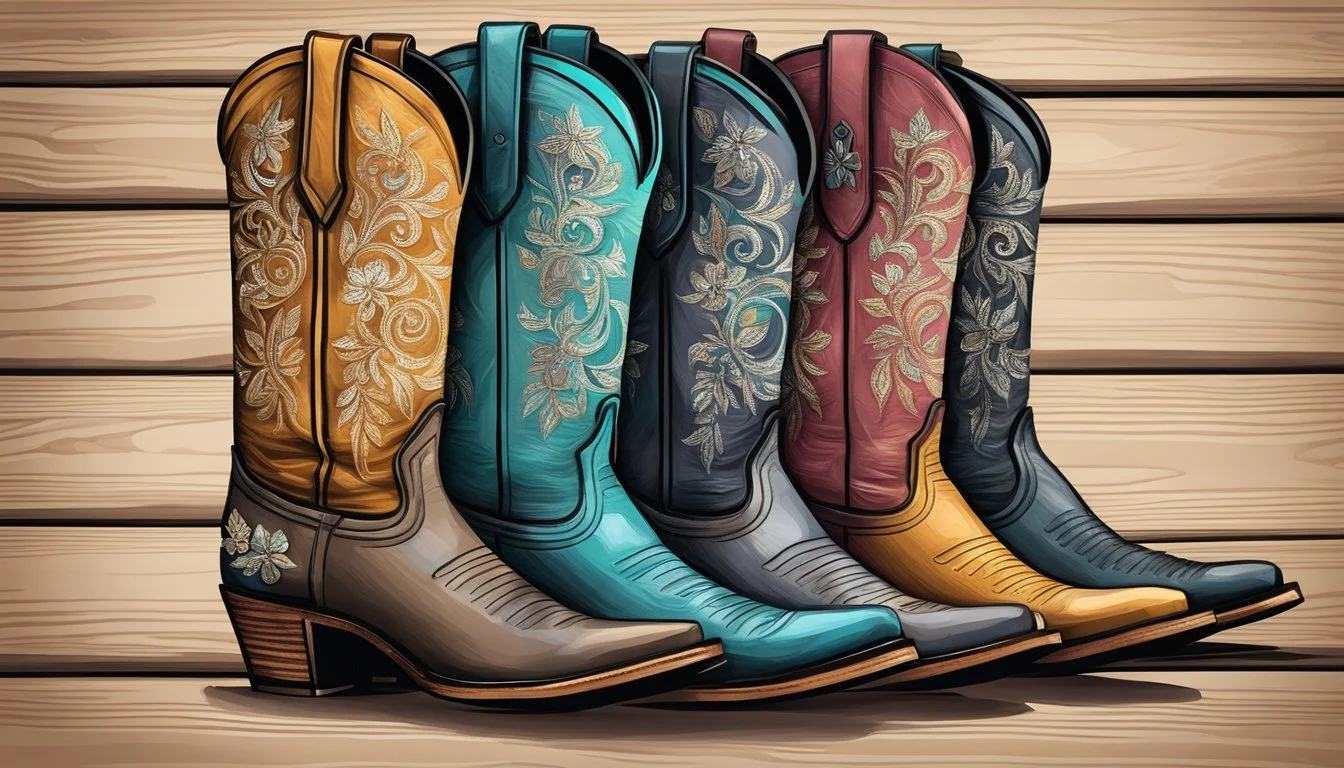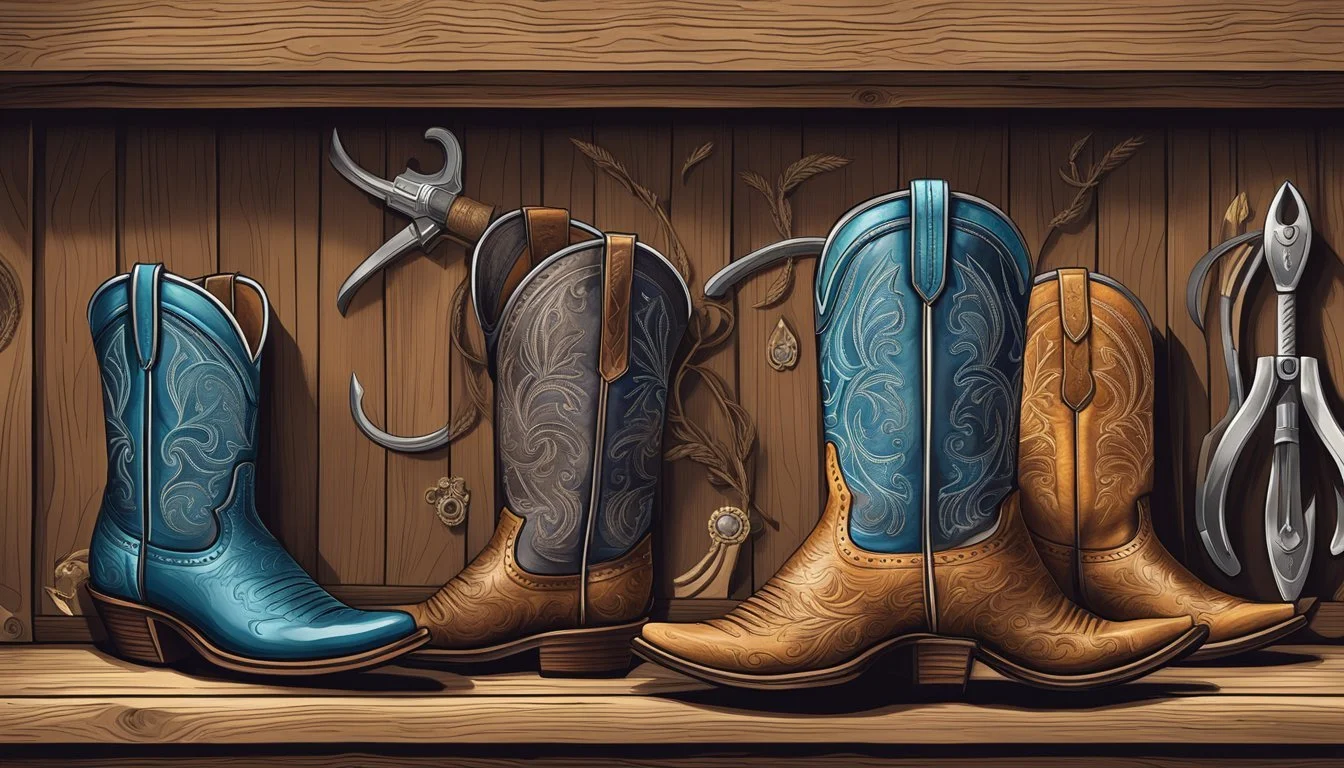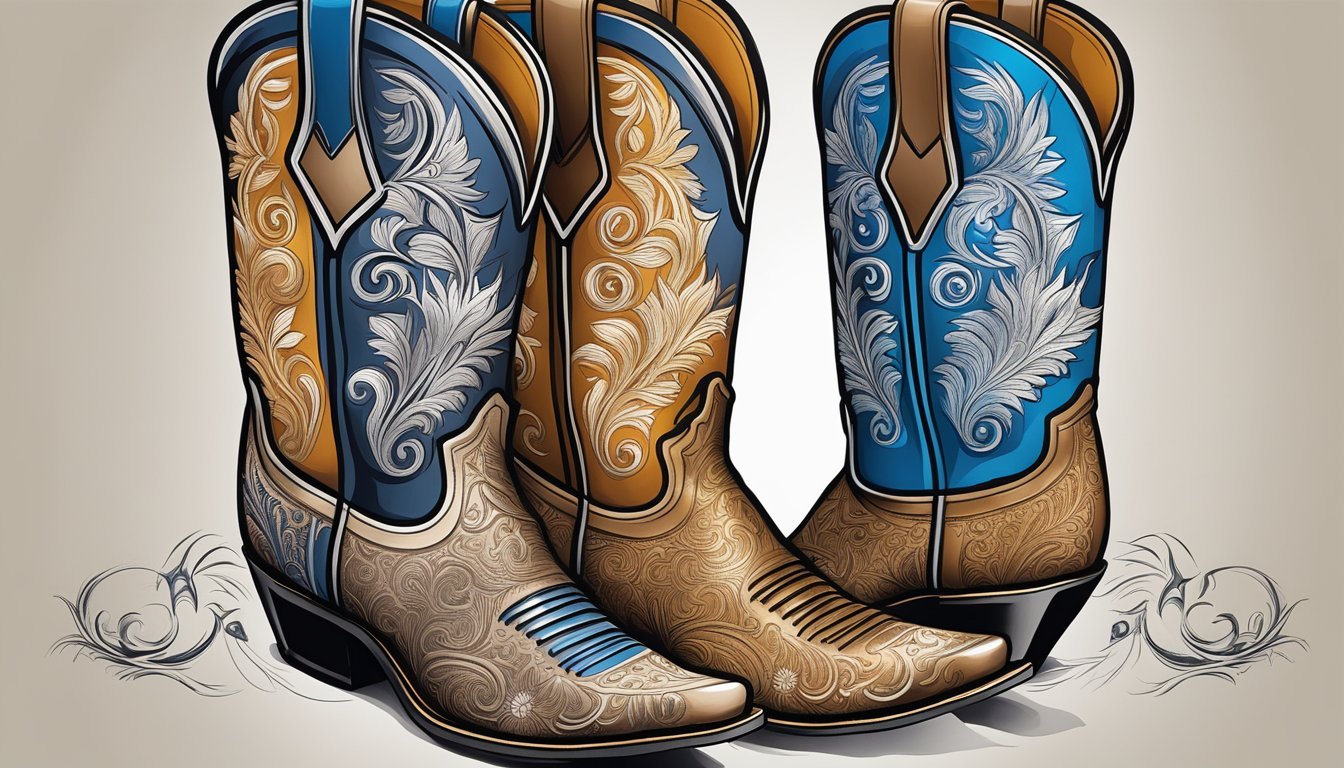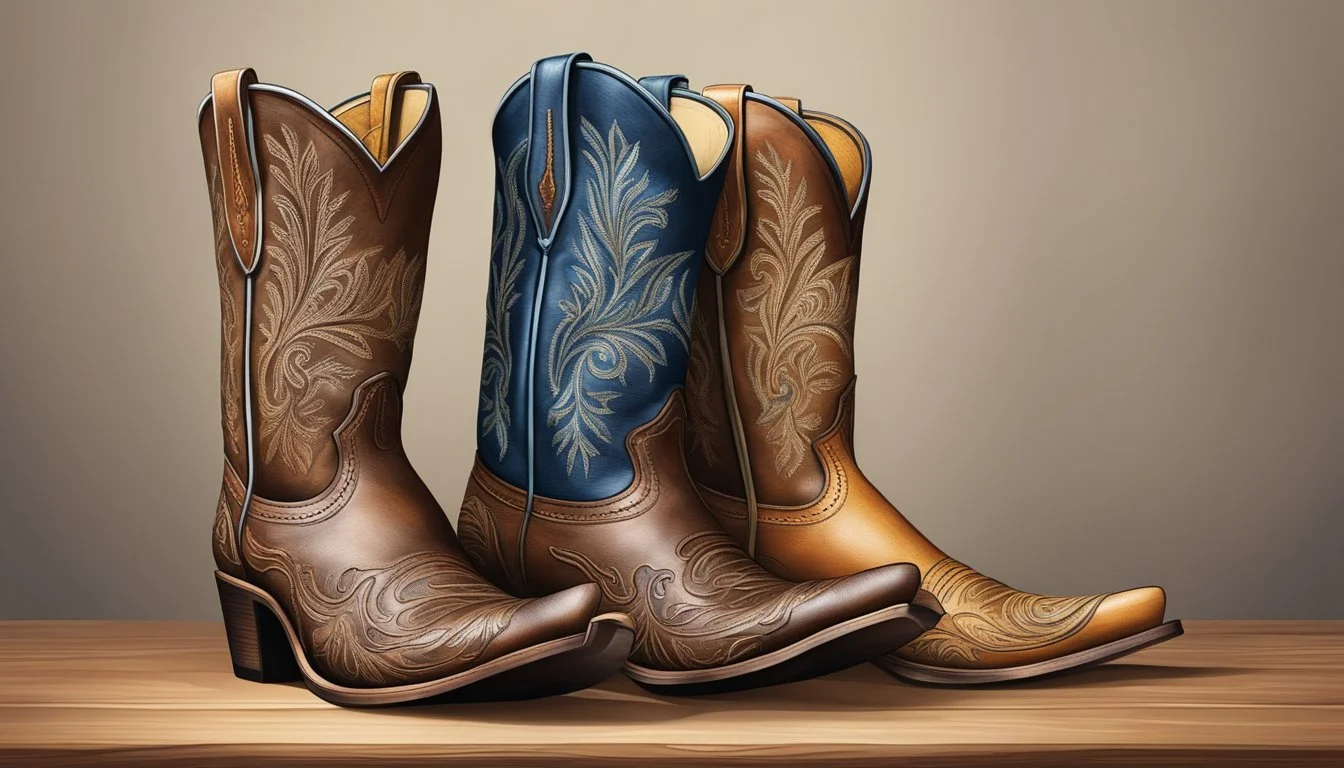The Texas Cowboy Boot
A Guide to Its Craftsmanship, Customization, and Care
The Texas cowboy boot holds a storied place in both American culture and the larger world of fashion. As a symbol of the rugged individualism and tradition of the Lone Star State, these boots are much more than just footwear—they are wearable art steeped in history. Skilled artisans across Texas dedicate themselves to the craft of bootmaking, combining time-honored techniques with modern aesthetics to create boots that are not only functional but also works of exceptional beauty and individuality.
Customization is at the heart of Texas cowboy boots, reflecting the personal style and preferences of their wearers. From intricate designs to unique leather choices, each pair is as distinct as its owner. The process starts with meticulous measurements to ensure an immaculate fit, followed by the selection of materials and patterns that resonate with the boot buyer's personality. Master bootmakers shape and stitch each piece of leather by hand, ensuring every detail is attended to with precision and care.
Maintaining a pair of cowboy boots is as important as its creation. Proper care, which includes regular cleaning, conditioning, and repairs, is essential to preserve the leather and the craftsmanship. Texas bootmakers not only create these enduring symbols but also offer guidance on how to maintain them. This extends the life of the boots, ensuring they can be worn with pride for generations. Whether for work or for display, the Texas cowboy boot is an enduring testament to skilled craftsmanship and cultural heritage.
History and Evolution of the Texas Cowboy Boot
The Texas cowboy boot stands as a testament to both tradition and transformation, tracing its roots back to the vaquero practices and evolving through the needs of American cowboys. This section delves into the origins of this iconic footwear, examines key design developments over the years, and explores the enduring influence of the vaquero tradition.
Origins and Significance
The cowboy boot originated from the practical need for more suitable footwear in the demanding environments encountered by cowhands and horsemen of the American West. They were influenced by the gear of the vaqueros, skilled horsemen who managed cattle in New Spain, later known as Mexico and the Southwestern United States. These early boots were crafted for durability and functionality, featuring a high top that protected the leg and a smooth sole that allowed for quick and easy foot release from the stirrups.
Key Developments in Cowboy Boot Design
Materials: Initially made from cowhide leather, cowboy boots have since incorporated a variety of materials, including exotic leathers like alligator and snake.
Toe Styles: The pointed toe design evolved for easier insertion into a stirrup, while the rounded and square toes were later iterations for different comfort preferences.
Heels: The under-slung heel design is recognized for its functional purpose in preventing a rider's foot from slipping through stirrups during ranch work or horse riding.
Stitching: Embellishments and intricate stitching patterns became popular, moving the boot from strictly utilitarian to a work of art and a sign of personal expression.
Influence of the Vaquero Tradition
The vaquero, the early Spanish and Mexican cowboys, were the first to influence what would become the American cowboy and their iconic boot style. Their methods and gear significantly shaped the cowboy boot's early design, which then adapted to the unique needs and cultural influences of Texas ranchers and cowboys. The vaquero's legacy carries on in the continued emphasis on skilled craftsmanship and the cultural symbolism of the boot within the cowboy tradition.
Design and Craftsmanship
The Texas cowboy boot is an emblem of heritage and skill, with design and craftsmanship that reflect both tradition and personal expression. Each custom boot is a masterpiece of artisanship, where materials and methods converge to create durable and stylish footwear.
Anatomy of a Cowboy Boot
The anatomy of a cowboy boot consists of various components:
Vamp: The front part of the boot that covers the top of the foot.
Shaft: The tall section that rises from the arch to above the calf.
Counter: Provides reinforcement at the heel’s back.
Toe box: Encases and protects the toes.
Pull straps/loops: Helps to pull the boots on.
Outsole: The bottom layer that comes in contact with the ground.
Each part must be expertly crafted to ensure the boot not only fits comfortably but also stands the test of time.
Unique Design Features
Cowboy boots boast unique design features that highlight personal style:
Stitch Patterns: Varied and intricate, they add a visual appeal and individuality.
Exotic Leathers: Ranging from ostrich (What wine goes well with ostrich?) to alligator, these materials bring distinctive textures and durability.
Cutouts and Inlays: Offer a three-dimensional quality and complexity to the design.
They infuse character into each pair, shaping them into individual works of art reflective of their wearer’s personality.
Artisans and their Techniques
The artisans, often referred to as master bootmakers, carry forth time-honored techniques in each custom boot creation:
Hand-selecting exotic leathers ensures the highest quality and uniqueness.
Implementing hand-tooling and carving designs to provide exceptional detail and customization.
Performing meticulous stitching by hand or using specialized sewing machines.
Their hands-on approach guarantees that every boot is not just made, but thoughtfully constructed with a dedication to excellence. Through their skills, these artisans maintain the tradition of cowboy boots while infusing them with contemporary designs for each custom order.
Custom Cowboy Boots
Custom cowboy boots reflect the wearer's personality and style, offering a blend of unique craftsmanship and individual expression. They cater to those seeking a perfect fit and personalized design created by experienced bootmakers.
The Custom Boot Process
The creation of custom boots begins with a personal consultation, where the customer's exact measurements are taken to ensure a perfect fit. Master bootmakers then select high-quality materials based on the customer's preferences. The assembly of custom boots is a meticulous process involving careful stitching, lasting, and finishing, often requiring several weeks to complete. Customers are involved in each step, from picking out leathers to choosing stitching patterns and boot styles.
Personalization and Style
Personalizing cowboy boots allows customers to express their individual style through various elements such as:
Leathers: Exotic or traditional leathers
Colors: Specific hues for the leather, stitching, and inlays
Stitching: Elaborate designs or simple patterns
Cut: Classic, contemporary, or unique silhouettes
Embroidery and Inlays: Symbols and images that represent personal interests or heritage
Noteworthy Cowboy Boot Makers
Several Texas bootmakers have gained recognition for their handcrafted custom cowboy boots, each with its own style and legacy:
Lucchese: Known for luxury boots, Lucchese combines traditional craftsmanship with intricate designs.
Stallion Boots: They offer a wide range of handmade boots that blend modern tastes with classic style.
Rocketbuster: Famous for whimsical and highly detailed custom designs tailored to their clients' preferences.
Rios of Mercedes: With a history dating back to 1853, Rios of Mercedes is respected for their quality leather and durability.
These master bootmakers use their skills to craft boots that are as much a piece of art as they are functional footwear.
Materials and Durability
The resilience of cowboy boots begins with the selection of premium leathers and is solidified through meticulous craftsmanship. A variety of exotic leathers and steadfast construction techniques contribute to the durability of these iconic footwear pieces.
Selecting the Finest Leathers
The cornerstone of lasting cowboy boots is the use of the finest materials. Texas bootmakers often source leather from the best tanneries globally, ensuring high-grade cowhide and superior durability. They procure leathers that are not only tough but also supple to withstand daily wear while providing comfort.
Exotic Leather Varieties
In addition to traditional cowhide, Texas bootmakers utilize a range of exotic leather options:
Alligator and Crocodile: Highly durable with distinctive patterns.
Ostrich: Known for its unique texture and flexibility.
Snake: Valued for its intricate, natural designs.
Shark: Touted for its resistance to wear and water.
These exotic leathers offer unique aesthetics without compromising the boots’ longevity, provided they undergo proper care.
Durability through Quality Craftsmanship
The boots’ durability is enhanced by quality craftsmanship. Artisans construct each pair with precision, reinforcing stress points and ensuring robust stitching. Handmade construction is synonymous with personalized attention to detail, which extends the lifespan of the boots. Properly crafted cowboy boots can withstand the rigors of time, symbolizing the harmonious blend of art and resilience.
The Role of Cowboy Boots in Fashion
Cowboy boots have traversed the journey from utilitarian footwear designed for horseback riding to becoming a staple in the global fashion industry. They symbolize a unique blend of tradition and trendiness, influencing various fashion segments and demographics.
From Functional to Fashionable
Originally crafted for the practical needs of cattle ranchers, cowboy boots quickly ascended into the fashion ecosystem. They transcended their functional role due to their distinctive style, which includes a pointed toe, a high shaft, and no lacing. Their durability coupled with the ease of slipping them on and off made cowboy boots appealing to a broader audience beyond the ranches of Texas.
Celebrity Influence on Cowboy Boot Trends
The personal style of celebrities has always had a significant impact on fashion, and cowboy boots are no exception. Roy Rogers and Cher, among others, showcased cowboy boots as an expression of individualism and style, propelling them into the spotlight. Hollywood further cemented their status, with cowboy boots featuring prominently in Western films, adding to their allure and desirability.
Major Fashion Brands and Western Boots
Prominent fashion brands, including Ralph Lauren, have incorporated cowboy boots into their collections, blending traditional Western aesthetics with contemporary fashion. This integration by significant brands represents the boots' transition into mainstream fashion, solidifying their place as versatile pieces that can be styled in numerous ways ranging from casual to high fashion.
Through each subsection, cowboy boots are depicted not just as footwear but as a cultural icon that continues to evolve within the fashion industry while retaining their historical significance.
Fit, Comfort, and Care
When selecting cowboy boots, the essentials of fit, comfort, and in-depth care can significantly extend the lifespan of the footwear and enhance the wearer's experience.
Finding the Perfect Fit
The right fit for cowboy boots is paramount. A snug fit around the foot with space to move the toes ensures both comfort and proper foot alignment. Measuring both feet for length and width can help identify the ideal boot size, as it’s common for individuals to have slightly differing foot sizes. Leather cowboy boots should feel firm at first, as the material will stretch and mold to the wearer's feet over time.
Comfort Features and Innovations
Cowboy boots have evolved to include various comfort features like padded insoles and supportive arch technology. Different boot styles may have features catering to specific needs, such as reinforced heels for riders or cushioned insoles for prolonged wear. When choosing a boot, shoppers should consider the activities they will use them for and select a boot style equipped with the appropriate comfort innovations.
Care and Maintenance Tips
Proper care is crucial for preserving the quality of cowboy boots. Here are steps for maintenance:
Clean: Remove dirt with a soft brush or damp cloth.
Condition: Apply a quality leather conditioner to prevent drying and cracking.
Protect: Waterproofing sprays can guard against stains and water damage.
Store: Keep boots in a cool, dry place, preferably with a boot tree to maintain shape.
Following these tips helps maintain both the appearance and longevity of cowboy boots, ensuring they remain comfortable and stylish for years to come.
Cowboy Boot Culture and Identity
The Texas cowboy boot is an emblem of Texan spirit and American cowboy culture, reflecting both personal identity and broader societal influences.
Boots as a Symbol of Texan Identity
Cowboy boots represent more than just footwear in Texas—they are a powerful symbol of state identity and pride. Texas' oldest boot shop, established in 1853, is a testament to the deep-rooted tradition of boot crafting in the state. The intricate designs and custom fits are not merely functional; they embody the unique personalities of their wearers. In 2007, Texas House Resolution No. 151 named cowboy boots the official State Footwear of Texas, recognizing the footwear's significance in Texan culture. This acknowledgment cements the cowboy boot's status as a key element of Texan heritage and individual expression.
Cowboy Boots in the Entertainment Industry
Hollywood has had a substantial role in propelling the image of cowboy boots to international audiences. As key elements in Western films, cowboy boots have become synonymous with the rugged, adventurous lifestyle of American cowboys. The entertainment industry's portrayal has expanded the clientele for these boots, elevating them to fashion icons and pieces of Americana. Custom bootmakers in Texas often work with a variety of clients, from local ranchers to global celebrities, showcasing the boots' versatility and enduring appeal.
Buying Guide for Texas Cowboy Boots
When seeking Texas cowboy boots, purchasers should prioritize authenticity and craftsmanship. It is crucial to evaluate where to buy and understand the price to ensure value.
Where to Purchase Authentic Cowboy Boots
Authentic cowboy boots embody the spirit of Texas craftsmanship. Prospective buyers should look for reputable boot stores or visit traditional artisans who specialize in bootmaking. Artisan shops can provide a rich experience, allowing buyers to witness the art of bootmaking first-hand. Some renowned manufacturers, like Tecovas Boots, offer authentic designs that merge time-honored methods with modern aesthetics. They often provide a range of ready-to-wear options as well as the possibility for custom designs.
For the digitally savvy, official websites or authorized retailers can be an excellent source to find genuine Texas cowboy boots. Buyers can also explore local Western wear stores where experienced staff can assist with proper boot fitting.
Considering Price and Value
Price is a reflection of the materials and labor involved in producing quality cowboy boots. Here's a concise breakdown:
Materials: Authentic boots use high-quality leather, ranging from cowhide to exotic materials like ostrich or alligator. Each material affects the boot's durability, comfort, and price.
Craftsmanship: Artisan and designer boots carry a higher price tag due to their handmade nature, intricate designs, and customization options.
Brand: Well-established brands like Tecovas tend to offer a premium product that reflects their reputation for quality.
When considering boots, customers should weigh their budget against their need for durability, comfort, and style.
Price Range Expectations Lower End Basic leather, mass production, fewer customization options Mid Range Better quality leather, more style choices, some artisan features Higher End Top-quality materials, handcrafted details, extensive customization
In seeking value, one should not overlook the boot's purpose—whether for fashion, everyday wear, or work. Each purpose may justify a different level of investment, with more durable boots often costing more due to their construction and materials.
Future of Cowboy Boot Craftsmanship
The evolution of cowboy boot craftsmanship melds the steadfast preservation of traditional methods with state-of-the-art innovations. This balance ensures the longevity and relevance of these emblematic boots in the modern era.
Innovations in Boot Making
Technology Integration: As the industry embarks on a new chapter, expect to see a rise in the utilization of advanced technologies. They will contribute precision to the boot-making process with the potential inclusion of 3D printing for custom fits and laser etching for intricate design details.
Material Advancements: The leather and materials employed in boot construction are set to become more diverse. Cowboy boots may soon incorporate eco-friendly and -synthetic materials that offer durability, comfort, and aesthetic versatility without compromising the boot's integrity.
Preserving the Bootmaking Tradition
Master Boot Makers' Role: The crux of cowboy boot creation remains in the hands of master boot makers. They are the custodians of heritage, ensuring each stitch and cut reflects the centuries-old craftsmanship while mentoring a new generation of artisans.
Emphasizing Craftsmanship: Prominent bootmakers in Texas, who have upheld the bootmaking legacy since as far back as the 1850s, continue to emphasize handcrafted precision. Workshops and apprenticeships are becoming key in sustaining the necessary skillset for bespoke cowboy boots that carry the spirit of the West.
Accessorizing with Cowboy Boots
Accessorizing with cowboy boots involves selecting fashion pieces that complement the boots' unique style and integrating hats and stirrups for a cohesive look.
Complementary Fashion Pieces
Earrings, necklaces, and rings often serve as the perfect complements to cowboy boots, enhancing the overall aesthetic appeal. Specifically:
Earrings: Opt for styles that echo the design elements of the boots, such as metallic studs or beaded dangles that match the boots' embellishments.
Necklaces: A simple leather chord with a pendant or a bold turquoise necklace can accentuate the craftsmanship of the cowboy boots.
Rings: Chunky silver or gold rings add a touch of rustic luxury, mirroring any metallic accents on the boots.
The goal is to coordinate accessories with the texture, embellishments, or color of the cowboy boots, creating a harmonious outfit.
Choosing the Right Hat and Stirrup Combinations
Hats play a crucial role in cowboy attire, serving both functional and fashion purposes:
Stetsons and other wide-brimmed cowboy hats should match the color tone of the boots for a coordinated appearance.
For events that involve riding, selecting a hat that fits securely is as important as the styling, ensuring comfort and practicality while on the saddle.
Stirrups are a key component in equestrian gear, and they should also be considered when accessorizing:
Choose stirrups that are the right size and style to match the boots. For example, stirrups with leather detailing can complement a pair of fine leather cowboy boots.
The metal of the stirrup—whether it be steel, aluminum, or covered in leather—should not clash with any metal accents on the cowboy boots or belt buckle.
By paying attention to these details, one can create a cohesive and stylish look that respects the traditions of cowboy fashion.
Industry and Community
The Texas cowboy boot industry intertwines skilled craftsmanship with deep community ties, reinforcing both the economic and cultural fabric of the region.
The Economic Impact of Cowboy Boot Making
The industry is a significant contributor to the local economy, employing numerous cowboy boot makers who maintain the tradition of handcrafting boots. These artisans work with a variety of boot styles, catering to a diverse market that values both function and fashion. The custom boot-making process often involves international collaboration, relying on materials such as dyes and animal hides from Western Europe, foot molds from Mexico, and design aesthetics that reflect global influences.
Community and Educational Outreach
Cowboy boot makers do not only focus on the economic aspect but also actively engage in community and educational outreach. They uphold a legacy by involving younger generations through apprenticeship programs and demonstrating the art at local events. Through educational outreach, the community remains connected to this cultural hallmark, ensuring the transfer of knowledge and the continuity of the industry.
Conclusion
The craftsmanship involved in creating Texas cowboy boots has a rich history, reflecting a tapestry of cultural influences. Artisans, many with origins in Mexico, continue to produce these emblematic boots, utilizing skills passed down through generations. They blend traditional methods with a variety of leathers, often imported from different regions, to craft items that are both highly functional and artistically expressive.
Customization is at the heart of the Texas cowboy boot industry. Each pair is often a unique representation of the wearer's individuality, with possibilities for personalization ranging from choice of material to elaborate designs. The art of custom boot-making is preserved and celebrated as an integral part of Texas's material culture, and has been solidified through legislative acknowledgement with cowboy boots being designated the official state footwear.
Caring for these boots requires a level of attention that matches the bootmakers' dedication. Owners are advised to condition the leather, maintain a proper shine, and protect the stitching to ensure the longevity of their boots. The meticulous care mirrors the careful construction, ensuring that Texas cowboy boots remain durable and meaningful for years to come.
In synthesizing the information on the Texas cowboy boot, it is evident that it stands as a symbol of craftsmanship and culture. It is an enduring piece of Americana, with both regional and international roots, that continues to evolve while always paying homage to its storied past.

